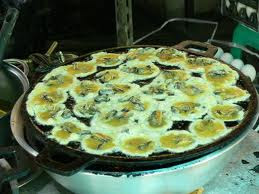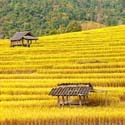Floating Market (TARADNAM BANGNAMPUNG) in SAMUT PRAKRAN PROVINCE
Floating Market. Where there is good weather. Ranked first in four of Asia.The facade of shops and walk the 2 km long canal parallel to line a small soi.From the Chao Phraya River into the area of farm people home Distribution of various tree species. Different fish species. Gold blank best Prior to the floating market of thisBecause the food here very diverse Noodle, Fish Maw, nest, and a noodle restaurant that we rarely meet. But do not eat a full stretch. Because the foods that rarely see from the cost more like Khanomkrok Fried, Fried fish, ink, eggs inserted wood wrapped in banana leaves, informed Ron, wrapped Mong Ku, Ball Ancient both Steamed Shrimp Fried taro, carrot, dessert, native of skill villagers.Like dessert cup, dessert from, fried banana, Ma Hong, dessert family gold, caramel agitation, shredded money to whites in boiling syrup sweet succulent neck, the bear within traditional food, etc. But this just is not all that. Also still have to prove yourself.
Moon Cake Festival
Cake table decoration contest (The table at the outdoor, second from sugar cane the invention is the arch
Vegetarian food on the table. Ko Moon Cake and Dessert for Women
Moon Goddess contest organizer) Visit Autumn Festival parade on September 22, 2553 at Thung Yao, Muang Trang.
For more information visit www.amd.com. Thung Yao Municipal Tel. 0-7528-9510 Tourism Authority of Thailand,
Trang Office Tel. 0-7521-5867, 0-7521-1058.
Mae Hong Son province
Mae Hong Son province is near the top of the North Thailand
Is one of several provinces in western Thailand. That is unique in several characteristics.
Both terrain and population groups from several nations.
Is the least populated provinces in the country. The third-largest population of little more space and is ranked eighth in the country.
History of the province Nong Khai


Wihara Phra Mongkhon bophit (Temple) in Ayutthaya

Phra Buddha Mongkol Bopit It is Bush bronze body as black as lacquer and gilded it.

Chiang Khan of Loei Province Northeast of Thailand

Northeast of Thailand Khan ... is a small district. This is a long ... The beautiful scenery along the Mekong River.
The old house. Along the road along the Mekong. But ... now being converted into a hotel. Progress House and small. That is lovely in the shop chic cute hair clip in the city Khan.
What is a coffee shop. What is a souvenir shop. Selling handmade postcard lovely other.
T-screen pretty. Sit and drink cool.
Write a postcard teak leaves. This time she seemed to turn slowly, "Khan."




Tak Bat Dok Mai Festival

The Tak Bat Dok Mai floral offering merit-making ritual is unique to Saraburi province. This ritual stands out from the merit-making activities conducted in the other parts of Thailand because in addition to the offerings of cooked rice, food, incense, candles and other conventional sacred items, the Tak Bat Dok Mai ritual includes offerings of Dok Khao Phansa flowers that only come into bloom during the Buddhist Lent, hence the origin of its name. Some villagers call the flower Dok Yung Thong (golden peacock) or Dok Hong Thong (golden swan flower).
 |
The Dok Khao Phansa is a native species of forested hill-slopes, and is most commonly found in Saraburi province. A member of the Globba family, the flower is similar to galingale or turmeric and is just over 25 centimetres in height. The plant somewhat resembles the "krachai" or aromatic ginger with flowers in large white, yellow, yellowish-violet, or violet and blue sprays. The yellow flowers have smaller violet petals that give it a striking appearance. As the Dok Khao Phansa becomes an increasingly rare find these days, lotus, jasmine and rose have become acceptable alternatives for these floral offerings.
The residents of Amphoe Phra Phutthabat have observed this tradition of making floral offerings since ancient times and it has now become a significant provincial event.
The "Tak Bat Dok Mai" floral merit-making ceremony is performed at the Wat Phra Buddhabat Woramahaviharn - Shrine of the Holy Footprint, a highly revered ancestral place of worship and a national landmark, in the Phra Buddhabat District of Saraburi province.
In the morning of the first day of the Buddhist Lent, residents of the community engage in merit-making activities by presenting offerings to the resident monks at the Wat Phra Buddhabat temple. Later in the morning, young couples venture out into the forested foothills to gather the Dok Khao Phansa flowers. Meanwhile in the district area, the candle procession and the "Tak Bat Dok Mai" procession head towards the temple courtyard.
 |
As a prelude to the floral merit-making ritual which takes place in the afternoon, a variety of traditional folk games and cultural performances are featured. Contests such as the long-drum dance, candle and Thai costume contests keep the audience entertained. In preparation for the "Tak Bat Dok Mai" merit-making ritual, Buddhist devotees line up along both sides of the street forming a long line that extends from the "mondop" or seven-tiered temple spire and trails back along the streets. This forms a passage along which hundreds of monks and novices file past to accept sacred offerings.

The monks then ascend to the Shrine of the Holy Footprint where the offerings received are in turn presented as a tribute to the Lord Buddha. Once the ritual has been completed, the Buddhist devotees pour water over the feet of the monks and novices in the belief that in doing so, the sins of the worshippers are washed away.

















